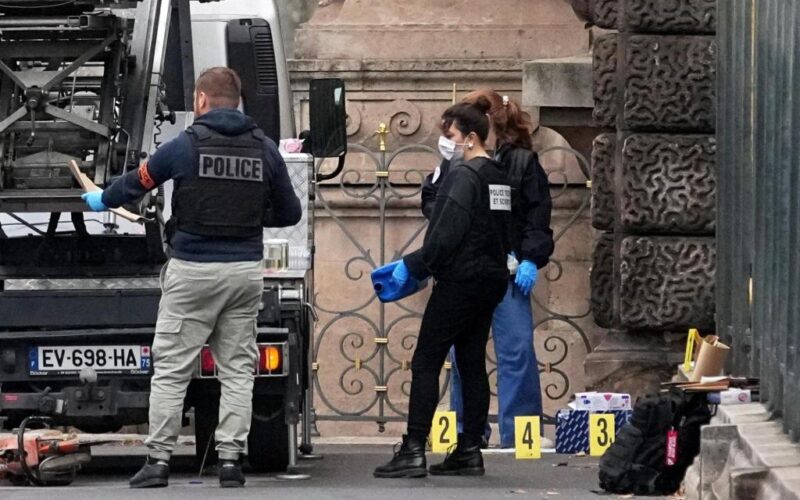BY NICOLAS VAUX-MONTAGNY and SAM METZ, Associated Press
PARIS (AP) — More than 100 investigators are racing to piece together how thieves pulled off the brazen heist at the Louvre Museum in Paris, working to recover the stolen gems and bring those responsible to justice.
The daytime theft of centuries-old jewels from the world’s most-visited museum thought to be of significant cultural and monetary value has captured the world’s attention for its audacity and movie plot-like details.
But thus far little has been revealed about how the investigation is unfolding, a source of frustration for those accustomed to the 24-hour flow of information in American true crime or British tabloids.
Suspects, like the jewels themselves, have remained out of sight, the case file cloaked in mystery and French authorities characteristically discreet.
Paris prosecutor Laure Beccuau said on Sunday that more details would come once the suspects’ custody period ends, likely around midweek, depending on the charges. But here’s what we know so far about the case:
What investigators want to know
Authorities said it took mere minutes for thieves to ride a lift up the side of the museum, smash display cases and steal eight objects worth an estimated 88 million euros ($102 million) on Oct. 19. The haul included a sapphire diadem, necklace and single earring from a set linked to 19th-century queens Marie-Amélie and Hortense.
Beccuau has not publicly announced what charges the suspects could face, though French media have reported that the charges include criminal conspiracy and organized theft, which can carry hefty fines and yearslong prison sentences.
How France handles arrests
Beccuau said investigators made several arrests Saturday evening but didn’t name them or say how many. One suspect, she added, was stopped at a Paris airport while trying to leave the country.
In France, where privacy laws are strict, images of criminal suspects are not made public as they often are elsewhere. Suspects aren’t paraded before cameras upon arrest or shown in mugshots.
The presumption of innocence is inscribed in France’s constitution and deeply valued throughout society. The French often express shock at the spectacle of criminal trials in the United States, including in 2011 when media outlets photographed Dominique Strauss-Kahn, then a candidate in France’s presidential election, on a “perp walk” to a New York prison after he was indicted on charges he sexually assaulted a hotel maid. The charges were eventually dismissed.
Information about investigations is meant to be secret under French law, a policy known as ″secret d’instruction” and only the prosecutor can speak publicly about developments.
Police and investigators are not supposed to divulge information about arrests or suspects without the prosecutor’s approval, though in previous high-profile cases, police union officials have leaked partial details. Beccuau on Saturday rued the leak of information about the ongoing investigation.
A police official, who was not authorized to speak publicly about the ongoing case, told The Associated Press that two men in their 30s, both known to police, were taken into custody. He said one suspect was arrested as he attempted to board a plane bound for Algeria.
Additional arrests may follow as the investigation continues.
Inside the investigation
The more than 100 investigators that Beccuau said are assigned to the case are combing through 150 DNA samples, surveillance footage and evidence left behind in the thieves’ wake.
Those assigned include the Brigade for the Repression of Banditry, the special police unit in charge of armed robberies, serious burglaries and art thefts.
Recovering the jewels could be among the most difficult parts of investigators’ work. French authorities have added the jewels to Interpol’s Stolen Works of Art Database, a global repository of about 57,000 missing cultural items.
Interpol, the world’s largest international police network, does not issue arrest warrants. But if authorities worry a suspect may flee, Interpol can circulate the information using a color-coded notice system.
The French investigators can also work with European authorities if required. They can turn to the European Union’s judicial cooperation agency, Eurojust, or its law enforcement agency, Europol. Eurojust works through judicial cooperation between prosecutors and magistrates, while Europol works with police agencies.
Both can help facilitate investigations and arrests throughout the 27-member bloc. Requests for help must come from the national authorities, and neither organization can initiate an investigation.
What happens next?
Beccuau said more details would be released once the suspects’ time in custody expires. How long that lasts depends on what they’re accused of. If, as French media have reported, they’re being investigated for criminal conspiracy, they can be held for up to 96 hours before charges are filed.
But don’t expect a flood of updates. Indictments and verdicts are not routinely made public in France. French trials are not televised, and journalists are not allowed to film or photograph anything inside the courtroom during a trial.
Metz reported from Rabat, Morocco. Molly Quell contributed reporting from The Hague.
Originally Published:











